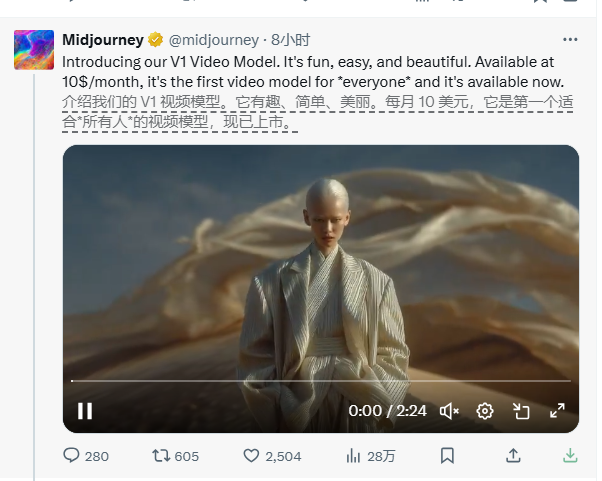Midjourney officially released its first AI video generation model, V1, marking a new milestone for the company known for image generation as it ventures into the multimedia creation domain. As a leading AI creative platform globally, Midjourney's release has drawn significant attention from digital artists and video creators alike. This article, compiled by the editorial team of AIbase using the latest online information, provides a detailed interpretation of the core highlights and future potential of the V1 model.

From Static to Dynamic: The Core Functions of V1 Model
The Midjourney V1 video generation model focuses on the Image-to-Video (I2V) function, allowing users to convert static images into dynamic videos via the "Animate" button on the web interface. The default video length is 5 seconds, with four different video segments provided each time, from which users can select the most suitable version. Additionally, the video duration can be extended in increments of 4 seconds, up to a maximum of 20 seconds.
V1 offers two motion modes:
Low-Dynamic Mode: Suitable for environmental scenes, where the camera remains relatively stable, and the subject moves slowly or deliberately to create an immersive atmosphere.
High-Dynamic Mode: Ideal for scenes with stronger rhythm, delivering more impactful visual effects.
Users can choose the automatic animation mode, letting AI decide the motion method, or manually customize through text prompts to further adjust the creative direction of the video. Midjourney emphasizes that V1 inherits the high consistency of its image model V6.1, ensuring excellent detail and style in the generated videos.
Premium Pricing for Broad Creators
Midjourney aims for low cost and high accessibility, continuing its user-friendly pricing strategy with the V1 model. Users can experience video generation starting at $10/month with the Basic subscription plan, while Pro ($60/month) and Mega ($120/month) plans allow unlimited video generation in "Relax" mode. However, the computational cost of video generation is approximately eight times that of image generation, so users need to plan their monthly quotas wisely.
At present, Midjourney does not offer super-resolution enhancement or audio generation features; the current output resolution is 480p with a frame rate of 24 frames per second. Although it may seem basic compared to competitors like Runway Gen-4, Luma Dream Machine, or OpenAI’s Sora, its low barrier to entry and high-quality visual style still position it uniquely in the market.
Looking Ahead: Midjourney’s Grand Vision
In a blog post, Midjourney CEO David Holz stated that the V1 model is a crucial step toward achieving real-time open-world simulation goals. Instead of focusing solely on generating simple B-roll footage for Hollywood or advertising industries, Midjourney is dedicated to building AI models capable of creating interactive 3D simulations. Holz emphasized, “We need visuals (image models), we need to make them move (video models), these are the cornerstones to the future.”
The launch of V1 is not only a technical breakthrough but also injects new vitality into Midjourney’s ecosystem. Combined with its recently released V7 text-to-image model, users can generate images from text and seamlessly convert them into videos, forming a complete creative loop. This end-to-end creation process provides efficient tools for independent creators, digital artists, and small businesses.
Challenges and Controversies: Shadows of Copyright Litigation
Despite the buzz surrounding V1's release, Midjourney faces copyright infringement lawsuits from Disney and Universal Pictures. These two Hollywood giants accuse Midjourney's AI models of using their intellectual property (such as Star Wars and Minions characters) without authorization and generating near-replica images and videos. This litigation could pose challenges to Midjourney's expansion into video services and serves as a wake-up call for the entire generative AI industry regarding copyright norms.
User Feedback and Market Response
According to recent feedback online, the V1 model has received widespread praise from creators for its ease of use and visual beauty. Many users noted that even without complex prompts, V1 can generate videos with realism and fine details, particularly excelling in low-dynamic scenes. However, slight flickering issues may occur in high-dynamic scenes, indicating room for improvement in the technology.
Meanwhile, the release of V1 has sparked enthusiasm on social media. Creators have shared short videos generated by V1, showcasing diverse applications ranging from dreamy landscapes to sci-fi scenarios. Midjourney’s community activity has further increased, expected to attract more new users to its platform.
AIbase editors believe that Midjourney’s launch of V1 is not just a technical breakthrough but another push towards democratizing AI creative tools. Its combination of affordability and quality enables more independent creators to enter the video creation field at very low barriers. Although the current functions are somewhat basic, Midjourney's clear roadmap and grand vision indicate that V1 is just the beginning of its journey in video generation.
We look forward to Midjourney bringing more innovations in areas such as resolution enhancement, text-to-video functionality, and audio integration. Resolving copyright disputes will also be key to its continued leadership. AIbase will continue to follow Midjourney's developments and bring you the latest industry insights.
